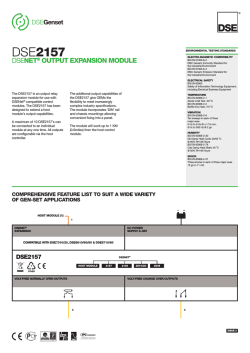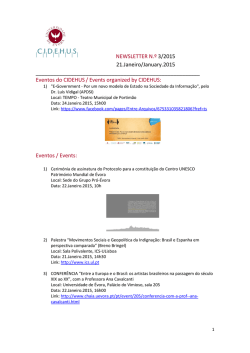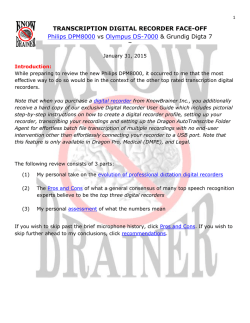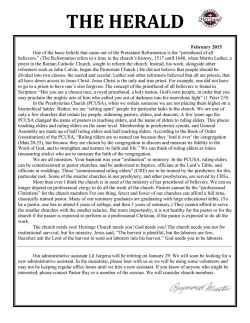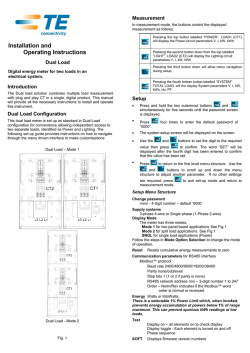
EMC_Information_Preservation_19052015a copy
INFORMATION PRESERVATION Since the beginning of mankind, we have recorded our cultural history using the latest technologies. Our cultural heritage has been captured and recorded in artworks, books, audio recordings, movies and TV programs, stored in museums and libraries around the world. However, many treasures are in locations where they are unprotected from the risks of degradation or destruction. RECORDING CULTURE, DOWN THE AGES How we’ve captured and recorded our beliefs, our knowledge, our entertainment: 30,000 BC CAVE PAINTINGS Images of animals and outlines of hands appear on cave walls in Europe and Asia. Their exact purpose is not known. 3,000 BC EARLY WRITING People in Sumeria, an ancient civilization in what is now southern Iraq, use pictograms as an early form of writing. 3,000 BC FIRST PAPER The earliest form of paper is developed from woven papyrus plants in Egypt, as well as in Greece and Rome. 2,600 BC FIRST LIBRARY Sumerians create the first library consisting of clay tablets. 1605 FIRST NEWSPAPER 1439 PRINTING PRESS 220 EARLY PRINTING 105 AD MODERN PAPER German publisher Johann Carolus prints Relation aller Fürnemmen und gedenckwürdigen Historien (Account of all distinguished and commemorable news). German blacksmith Johannes Gutenberg invents the first printing press with movable type, enabling mass production of books. The Chinese develop woodblock printing on cloth and paper. It spreads to Europe where it was common by 1300. A Chinese court official, Cai Lun, creates paper made from wood fibers and rags. The invention spreads slowly to other countries. 1827 FIRST PHOTOGRAPH 1860 FIRST SOUND RECORDING French printer Édouard-Léon Scott de Martinville invents the earliest known audio recording device, the phonoautograph. 1876 FIRST TELEPHONE French inventor Joseph Niépce pioneers a method of capturing light using polished pewter and bitumen. 1843 FIRST COMPUTER PROGRAM English mathematician Ada Lovelace describes how a proposed mechanical computer could solve mathematical problems. 1926 FIRST TELEVISION TRANSMISSION 1906 FIRST RADIO BROADCAST 1889 FIRST MOTION PICTURE 1887 FIRST GRAMOPHONES Scottish inventor John Logie Baird transmits live images of a moving face – the first public demonstration of television. Canadian inventor Reginald Fessenden broadcasts the first radio program to ships off the New England coast. US inventor Thomas Edison invents the Kinetograph, an early movie camera, and Kinetoscope, a machine on which to watch motion pictures. American inventor Emile Berliner develops the ‘Gramophone’ method of recording sound on flat discs, or records. 1935 FIRST TAPE RECORDER Electrical equipment maker AEG demonstrates the world’s first practical tape recorder, using magnetic reel-to-reel tape. 1959 FIRST COPYING MACHINE Xerox launches the world’s first commercially successful photocopier, making copies on ordinary paper. 1963 FIRST COMPACT CASSETTES Philips introduces the Compact Cassette format in Europe, and a year later in the US. 1972 FIRST VCR 1984 FIRST MOBILE PHONE 1982 FIRST COMPACT DISCS The Motorola DynaTAC 8000X, the most handheld cellphone, went on sale for $3,995. The first CDs were pressed by Philips in Germany and included The Visitors by ABBA. 1979 FIRST PERSONAL MUSIC PLAYER Sony introduces the Walkman, a compact and highly portable cassette player designed to be listened to while walking around. 1974 EARLY PERSONAL COMPUTERS The Altair is introduced as a mail-order kit. Its BASIC programming language was adapted by Bill Gates and Paul Allen. 1989 WORLD WIDE WEB 1991 FIRST WEBSITE 1994 FIRST SMARTPHONE 1999 FIRST DVRs Sir Tim Berners-Lee proposes a means to publish and share information using internet technologies. His proposal becomes the World Wide Web. The first webpage is created by Sir Tim Berners-Lee, then working for CERN in Switzerland. It describes how the World Wide Web operates. IBM’s Simon Personal Communicator goes on sale offering mobile email and faxes. It does not have a web browser. Digital video recorder pioneer TiVo ships its first products. 2010 FIRST iPAD 2007 FIRST iPHONE 2001 DIGITAL CAMERAS Steve Jobs introduces the iPad saying it will create a “third category” of devices between smartphones and laptops. Apple’s Steve Jobs unveils the iPhone, saying the “magical device” will transform the telecoms industry. Kodak begins selling mass-market digital cameras, first invented by Kodak engineer Steven Sasson in 1975. Scottish-born scientist Alexander Graham Bell is awarded a US patent for the electric telephone. The Video Cassette Recorder is launched in England by Philips. It costs the same amount as a small car. EMC INFORMATION PRESERVATION INITIATIVES EMC helps ensure cultural treasures are available for future generations to access and enjoy. Through our Information Heritage Initiative, EMC provides products, services, and financial assistance for digital information heritage programs worldwide. Projects include: JFK PRESIDENTIAL LIBRARY AND MUSEUM The John F. Kennedy Library Foundation is creating an online archive of the President’s life. This includes: 8.4 million 400,000 9,000 hours 7.5 million feet 1,200 hours pages of JFK’s presidential papers still photographs of audio recording of motion picture film of video recordings Archivists have seen a significant improvement in the processes for scanning, managing, and cataloging the large volume of priceless materials THE ROYAL INSTITUTION’S CHRISTMAS LECTURES THE ERNEST HEMINGWAY COLLECTION Christmas lectures have been presented by eminent scientists at the Royal Institution in London since 1825. The lectures have been broadcast on TV since 1966. Having awarded a Heritage Trust Grant, EMC is helping to digitize all the Christmas lecture recordings so they are available to audiences around the world. THE VATICAN APOSTOLIC LIBRARY Author and journalist Ernest Hemingway wrote For Whom the Bell Tolls at his home, Finca Vigía, in Cuba. The house – in which he lived from 1939 to 1960 – is today a museum filled with Hemingway’s irreplaceable letters, telegrams, photos and books. Through a partnership with the Finca Vigía Foundation, EMC is working collaboratively with Cuban colleagues to restore and preserve Hemingway’s vast collection. The Vatican Apostolic Library holds many of the rarest and most valuable documents in existence including the 42-line Latin Bible of Gutenberg, the first book printed with movable type. Over nine years, EMC will: • Help digitize the entire library, which includes nearly 90,000 historic books, manuscripts, documents and early papyrus texts • Provide 2.8 petabytes of storage capacity – enough to store the 40 million pages of digitized content THE USEK LIBRARY OF LEBANON The library at the Holy Spirit University of Kaslik (USEK) was founded by the Lebanese Maronite monastic order in 1938. The library’s mission is “to ensure the preservation and long-lasting availability of resources of national and ethnic heritage” and began preserving manuscripts of the order in 2003. Since then it has preserved: 10,000 manuscripts from Lebanon and Middle East – 4,000 have been digitized 1,500 rare books and special collections Since 2007 we have provided more than $37 million in products, services, and financial assistance for digital information heritage programs worldwide. At EMC, we redfine what's possible by transforming people's lives through the power of information. To learn more about EMC’s Information Preservation Initiatives, visit: http://emc.im/1nbMg08 EMC is providing: • Digitizing technology • Storage infrastructure • Backup and recovery systems
© Copyright 2026
